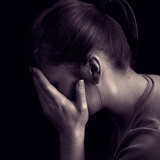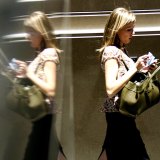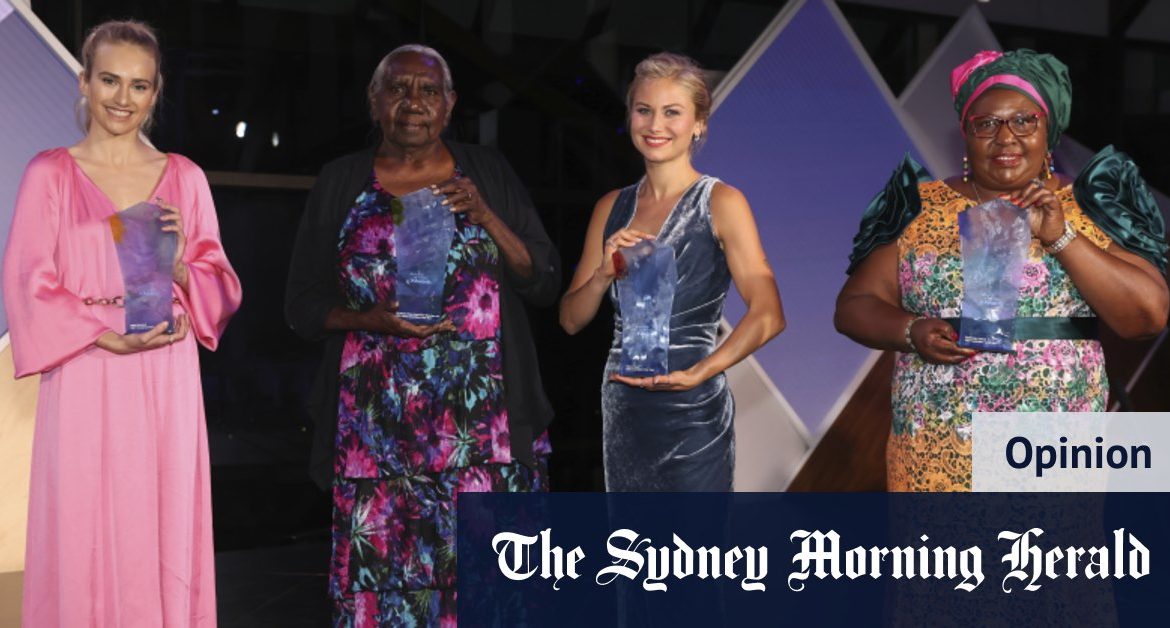After a gruelling year of pandemic, this awards ceremony seemed to be setting a new tone for our recovery path – a tangible and visible example of “building back better”, inspired by the honesty, integrity, diversity and courage of Australian women.
And yet here we are, just a month later, as International Women’s Day 2021 looms, in a distressing whirlpool of shocking allegations of rape and sexual assault, and daily reminders of our unsafe homes, streets and workplaces. This toxicity goes right to the top, right into the halls of political power.
More women have come forward with allegations of sexual assault and harassment by the same man Brittany Higgins said raped her in Parliament House.Credit:Alex Ellinghausen/The Project
No doubt we will learn even more in the days ahead, although women and girls across Australia have long known this in their bones – which is why they are now speaking to the individual and collective fury, anguish and indignation they feel. Witness Grace Tame’s extraordinary speech at the National Press Club.
In recent days, we have learned of an alleged rape in Parliament House, and another MP turning her back on a destructive male-dominated political environment.

Chanel Contos started a petition calling for better sex and consent education in schools.
We have read countless, horrifying testimonials from young women documenting how they were sexually harassed and assaulted by privileged young men from Sydney’s elite boys’ schools. And now, too, an historic rape allegation against a current federal minister.
The backdrop to all this is equally distressing. Despite the national outrage over the murder of Hannah Clark and her three children a year ago, Australia’s domestic and family violence emergency continues, with one woman every week murdered by a current or former intimate partner.
In late January, Ms R Rubuntja, a founding member of the Tangentyere Women’s Family Safety Group in Alice Springs, was allegedly murdered by her partner shortly after travelling to Canberra to speak with federal politicians about the prevalence of domestic violence in Central Australia.
This howl of pain is the soundtrack to millions of women’s lives.
During the initial stages of the pandemic, the Australian Institute of Criminology found that of 15,000 women surveyed, almost 5 per cent had been victims of physical or sexual abuse in the three months to May 2020, with almost 12 per cent suffering at least some form of emotional abuse.

Women experienced heightened levels of abuse during the COVID-19 pandemic.Credit:Shutterstock
The National Community Attitudes Towards Violence Against Women Survey has also revealed that while community knowledge and attitudes are generally improving, a worrying proportion of Australians still believe gender inequality to be exaggerated, or no longer a problem. A significant number also believe that women use claims of violence to gain tactical advantage in their relationships with men.
These attitudes, according to the research, contribute towards the violence and disrespect towards women.
Alongside this are the stories of women who have been deterred from progressing their careers into leadership positions.
The theme for IWD21 is “Women in leadership: Achieving an equal future in a COVID-19 world” with the purpose of forging a gender-equal world, where calling out inequality is key.
Australia is stubbornly resistant to gender equality, as if it’s still waiting for proof that gender equality advances society as a whole.
Six years ago, the McKinsey Global Institute released its report – based on a survey of 95 countries – showing that a staggering $US28 trillion would be added to annual global GDP by 2025 if women’s participation in the economy was equal to men’s.
The disparities between men and women in Australia are in plain sight – in the rates of full-time work participation, in the time spent in unpaid work, in the superannuation system (that is wilfully blind to parenting), and, in general, in a national gender pay gap of almost 15 per cent..
The economic pain of the COVID recession has not been shared equally. Women have been far more likely than men to lose their jobs, more likely to do unpaid work, and less likely to get government support. The effects of this will deepen the existing economic gaps between women and men long into the future.
There is a significant lack of support for women in leadership roles in this country, and I believe this reinforces many of the masculine tropes of power and privilege, particularly unexamined male privilege.
Our leadership challenge is real. Chief Executive Women’s ASX200 Senior Executive Census in 2020 revealed that progress in the number of women reaching senior leadership positions in ASX200 companies flatlined at 25 per cent for CEOs and 16 per cent for CFOs during COVID-19.

Women earn two thirds the amount of men over their lifetimes.Credit:Rob Homer
Most concerningly, the number of women CEOs in Australia has slipped since 2019 to just 10 today, and of the 25 CEO appointments made in 2020, only one was a woman.
Equally disappointing is that, as of 2020, only 38 per cent of members of the national parliament were women, while the Cabinet comprised only 27 per cent women. Compare this to Austria’s 57 per cent, Cost Rica’s 50 per cent, France’s 52 per cent and New Zealand’s 44 per cent according to the latest figures from Council on Foreign Relations.
Economic modelling by KPMG shows halving the workforce participation gap between men and women would increase Australia’s annual GDP by $60 billion by 2038.
We cannot leave a single resource untapped. We must work to create economic opportunity and jobs for all. As Australia rebuilds post-pandemic, we need to capitalise on the productivity of our entire workforce and minimise barriers to workforce participation.
Australian women represent one of the most highly educated human resources in the world, and yet our childcare and tax system prevent them from full participation, while a culture of harassment and assault causes incalculable damage and prevents them from leading.
Loading
Inspired by the courageous leadership of Grace Tame and our other three Australians of the Year, we need to rebuild from COVID-19 with accelerated progress on gender equality and construct a more inclusive and resilient nation, economy and community that fully commits to women being a central part of our national identity.
Australian men can, and must, play a vital role in this ambition, whether by learning from the leadership of young men like Cranbrook prefect Asher Learmonth who has called out widespread sexual assault in Sydney boys’ private schools, or engaging with the profoundly important work of journalist David Leser who invites men in his book Women, Men & the Whole Damn Thing to join him in a “ruthless self-interrogation, and, in doing so, become part of the change that is so urgently required”.
That change must start right now, by allowing more women to lead.
Sam Mostyn, AO, is a businesswoman and non-executive director. She chairs Australia’s National Research Organisation for Women’s Safety, is president of Chief Executive Women, and deputy chair of the Centre for Policy Development.
Ahead of International Women’s Day on March 8, The Age is publishing a series of reports on issues facing women in 2021.
Most Viewed in National
Loading







